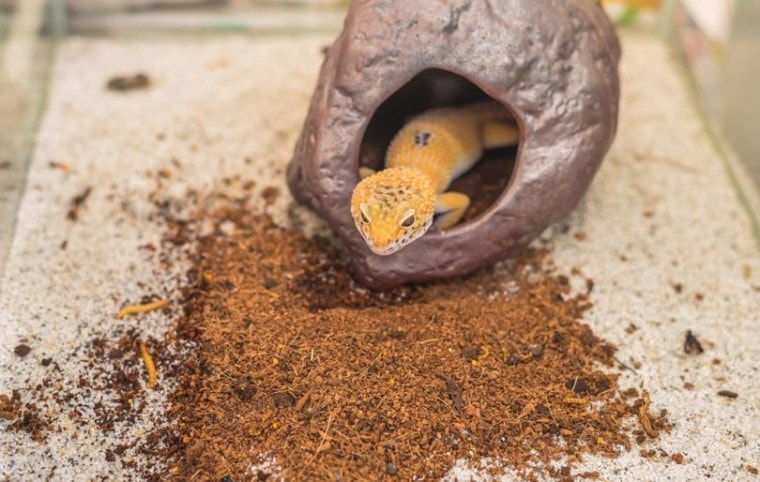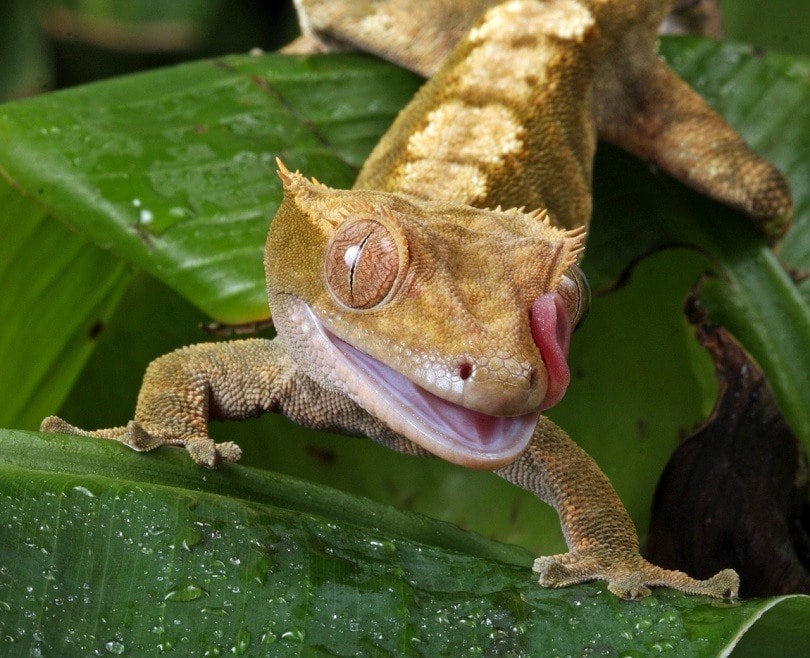
Click to Skip Ahead
Venturing into the captivating realm of leopard geckos? Native to the rocky, desert terrains of Afghanistan, Pakistan, and India, these nocturnal beauties make delightful and endearing pets. But remember, each leopard gecko, with their distinctive spots and vibrant hues, requires particular care to thrive in our cozy homes. Here’s a well-curated guide highlighting the top eight must-haves to ensure your leopard gecko feels right at home.
The 8 Essential Leopard Gecko Supplies
Enclosure Necessities
1. Tank Enclosure
Choosing the right terrarium is paramount for your leopard gecko’s well-being. The New Age Pet ECOFLEX Mojave Reptile Lounge stands out as a splendid choice. With dimensions spanning from a cozy 24-inch version (equivalent to a 29-gallon tank) to a roomier 48-inch variant (which boasts a vast near 240-gallon space), there’s a suitable size for every gecko enthusiast. These terrariums are thoughtfully designed with sliding glass doors that lock securely, ensuring your little buddy remains safe and sound.
Additionally, the mesh screen top is versatile enough to fit most UV and heat lamp arrangements, making temperature regulation a breeze. If you dread cumbersome assembly processes, there’s good news: setting up this terrarium is a tool-free, straightforward affair.
Whether you place it indoors or outdoors, this terrarium is dynamic enough for various reptilian pals, be it tortoises, other reptiles, or amphibians. Naturally, this includes your leopard gecko as well. Please note, though, that this product is a terrarium, not an aquarium. Despite its impressive holding capacity, it should not be filled with water. The product is designed to be used as a terrarium only.
2. Basking Spot
Basking assists in regulating a leopard gecko’s body temperature, aids digestion, and offers them a sense of security and comfort. An appropriate basking spot allows your pet to achieve and maintain optimal body temperature, which is crucial for their overall health and well-being.
We’re all about providing top-tier care for your reptilian friends. The Vila Bearded Dragon & Leopard Gecko Humid Hide Resin Cave & Basking Rocks ticks every box for an ideal basking spot. Not only does it provide a snug and concealed hideout, but its durable resin construction ensures longevity. The surface is finely smoothed, eliminating any sharp edges that might harm your pet. Moreover, the versatile design seamlessly fits both moist and dry environments. Its stair-like structure doesn’t just act as a cover but also doubles as a lounging area, enhancing its utility.
Weighing just 1 pound with dimensions that offer ample space (10 x 7.5 x 6.2 inches), it’s a basking spot that promises convenience without compromising on comfort. Crafted from robust polypropylene, it’s a reliable choice for a variety of reptiles, ensuring you get great value for your investment. Whether you have a leopard gecko or any of its other numerous compatible companions, the Vila Reptile Resin Cave is a must-have accessory in your reptile’s habitat.
Please note that your leopard gecko may not bask much on this spot. Interestingly, being nocturnal, leopard geckos tend to seek out “warm” stones in the evening (that have been sitting under a heating lamp or the sun) to regulate their temperature. Therefore, it is best to place this spot under the basking lamp so that it may absorb heat during the day, for your pet to use when they wake up in the evening.
At times, though, certain leopard geckos can become accustomed to waking up during the day. In such an event, you’ll likely catch your pet basking during the day to help regulate their temperature.
3. Lighting
Even though leopard geckos are nocturnal, they still may benefit from broad-spectrum lighting. Though leopard geckos don’t have specific lighting requirements, it has been postulated that a broad-spectrum light might be beneficial for leopard geckos.
Navigating the maze of lighting options, we’ve found the REPTI ZOO 100W Sun Basking Reptile Terrarium Lamp to be a standout choice. If you’re considering a light for your pet’s enclosure, this product is sure to be a safe bet.
4. Hiding Spots
Leopard geckos are naturally shy, especially during the day, and appreciate multiple hiding spots, caves, or sheds within their enclosure. They may also opt to use these spots when they’re shedding their skin.
The SunGrow Coco Shell Small Pet Hideout is an ideal choice for this purpose. It serves as a climbing and hiding space. The neutral design seamlessly integrates into any terrarium setup, ensuring aesthetics are in harmony with functionality.
5. Water Bowls
Just like us humans, leopard geckos need their hydration fix too! Even though they’re desert-dwelling creatures, they still crave a refreshing drink now and then. When it comes to water dishes, you want to keep it simple. The dish should be shallow enough for your gecko to access without diving in, and easy to clean. Our recent find, the Zoo Med Repti Ramp Bowl, ticks all these boxes. Crafted in the USA, this dish is sturdy—it feels like it could withstand a mini gecko party! Its ramp design makes it easy for your little friend to get in and out too.
The shape makes sure that there are no annoying nooks and crannies where dirt can hide. Remember, fresh water is key, so change it regularly. While they don’t need baths, gentle misting occasionally can be a delightful treat for your gecko during a shed. If you’re thinking of misting, there are some fantastic gecko-friendly misters available to keep things comfortable for your little friend.
Nutritional Essentials for Your Leopard Gecko
6. Protein Source
Protein is a pivotal part of a leopard gecko’s diet. For a vibrant and healthy gecko, it’s advisable to incorporate gut-loaded insects, such as mealworms or crickets.
Speaking of live feed, the spotlight is on the Ovipost Banded Adult Live Feed Crickets Reptile Food. These crickets are raised naturally and stand out as an excellent choice for leopard geckos due to their lively nature. Their constant movement triggers the geckos’ natural hunting instincts, making feeding time quite the spectacle. While there might be slight size variations among these crickets, they remain a nutrient-rich protein source for a range of creatures. So, if you’re looking to enrich your leopard gecko’s diet or treat other pets, these crickets are sure to be a hit.
Depending on where you reside, you might have to gut load your crickets for a day or so before feeding them to your pet.
7. Supplements
Supplements play an indispensable role in maintaining the health and vitality of your leopard gecko. Just like other reptiles, leopard geckos can sometimes fall short of getting adequate amounts of calcium and vitamin D3, leading to potential health concerns. It’s for this reason that integrating products like Zoo Med Repti Calcium with D3 into their diet can make all the difference.
Introducing such supplements can ensure your gecko receives these pivotal nutrients, and you might also ponder introducing a specialized reptile multivitamin for a more comprehensive nutrient boost.
This product boasts a formula with ultrafine precipitated calcium carbonate, eliminating concerns over impurities, phosphorus, or lead. Its distinct particle design promotes increased surface area, facilitating enhanced calcium absorption. Plus, for our beloved geckos who prefer staying indoors, this supplement packs an extra punch with vitamin D3.
Remember to always check with your exotic veterinarian before deciding to incorporate a supplement into your pet’s diet. Your veterinarian can also help you formulate a meal plan appropriate for your pet depending on their age, sex, health status, and activity levels. It is important to keep in mind that while supplements are beneficial, overdosing them can be potentially harmful for pets. Therefore, the value of a veterinarian’s input should not be underestimated.
Cleaning Supplies
8. Cleaning Supplies
When you’ve got a pet reptile running around, you’re going to want to ensure you clean up after them, especially if you let them run around on your counters (while closely supervised), your furniture, or other surfaces that you and your family might come in contact with.
The Hepper Advanced Bio-enzyme Pet Stain & Odor Eliminator Spray is the perfect cleaning solution for every pet owner. Unlike most other cleaners, this spray gets out tough stains and odors that come from our pets.
And if pet owners know one thing, it’s that pets can, at times, get pretty messy. While we don’t recommend using this product inside your gecko’s enclosure, it’s perfect for cleaning up after them, like if they have an accident on your favorite rug.
This spray was formulated specifically with pets in mind. Plus, it works on floors, furniture, carpet, or mostly anything else you might need to clean. On top of that, it has a neutral scent, so it won’t bug those with a sensitive nose.
Final Thoughts
It is exciting to set out on an adventure with a leopard gecko. If you provide the right environment and care for their needs, you can create a bond that will last a lifetime. Keep in mind that maintaining a healthy habitat is just as important as eating right.
Good luck setting up the perfect home for your new gecko friend!
Featured Image Credit: BLUR LIFE 1975, Shutterstock
















